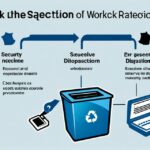The Secure Path to Workstation Disposal
In today’s digital age, UK businesses face the challenge of securely disposing of outdated PC workstations while ensuring responsible recycling practices. The confidential data stored on these workstations makes secure disposal a crucial step in protecting sensitive information. By adhering to ISO 27001:2022 Annex A 7.14 guidelines, companies can implement effective security measures and procedures to preserve data confidentiality during disposal or re-use.
UK businesses need to prioritize responsible recycling and trust reputable IT asset disposal service providers. These providers have the expertise to handle the secure disposal of PC workstations, ensuring that sensitive data is safely removed from the devices and that the equipment is recycled in an environmentally friendly manner. By partnering with the right service provider, organizations can establish a secure path to workstation disposal, protecting both their data and the planet.
Protecting Data Through Secure Disposal Processes
When it comes to the disposal or re-use of IT equipment, protecting data and ensuring data confidentiality is paramount. ISO 27001:2022 Annex A 7.14 provides specific guidelines that organizations should follow to safeguard sensitive information during the disposal process. By implementing these secure disposal processes, businesses can minimize the risk of data breaches and maintain compliance with industry standards.
Equipment Erasure and Physical Destruction
One of the key aspects of secure disposal is the complete erasure or physical destruction of data stored on IT equipment. This can be achieved through various methods, such as:
- Overwriting data: By overwriting the existing data on storage devices, organizations can ensure that the information is no longer accessible. This process involves replacing existing data with random characters, making it nearly impossible to recover.
- Physical destruction: For certain equipment, physically destroying storage media devices may be necessary to ensure that data cannot be recovered. Physical destruction methods may include shredding, crushing, or melting the devices to render them irreparable.
Removal of Controls
In addition to erasing or destroying data, organizations need to consider the removal of controls that may compromise data confidentiality. This may include:
- Access restrictions: When vacating facilities, organizations should remove access restrictions such as keycards or biometric systems to prevent unauthorized entry.
- Surveillance systems: If the disposed equipment includes surveillance systems, organizations should disable or remove them to eliminate the risk of unauthorized access to recorded data.
By taking these measures, organizations can mitigate the risk of data breaches and ensure that no sensitive information falls into the wrong hands.
“Secure disposal processes, including equipment erasure and physical destruction, are essential for protecting data confidentiality and mitigating the risk of data breaches.”
Image:
Ownership and Compliance with ISO 27001:2022 Annex A 7.14
Compliance with ISO 27001:2022 Annex A 7.14 is imperative for organizations seeking to establish a robust security framework for the disposal and re-use of IT equipment. To achieve compliance, organizations must develop an organizational-wide data disposal-reuse procedure that encompasses key elements such as equipment identification, technical disposal mechanisms, and responsible ownership.
A comprehensive approach to compliance with Annex A 7.14 ensures that organizations have clear guidelines and processes in place to maintain the confidentiality of data throughout the disposal and re-use lifecycle. At the forefront of this effort is the Chief Information Officer (CIO), who plays a pivotal role in setting up, implementing, and maintaining the necessary systems and processes.
The organizational-wide data disposal-reuse procedure outlines the specific steps and measures that need to be followed when disposing or re-using IT equipment. It encompasses identifying all equipment that is subject to disposal or re-use, implementing suitable technical disposal mechanisms, and determining the individuals or departments responsible for overseeing the process.
By implementing effective technical disposal mechanisms, organizations can ensure that data is securely and permanently erased from IT equipment. These mechanisms may include data overwriting or physical destruction of storage media devices. It is crucial that organizations select the appropriate mechanisms based on their specific requirements and risk assessments.
Responsible ownership is another critical aspect of compliance with Annex A 7.14. Organizations should clearly assign ownership of the disposal and re-use process to ensure accountability and adherence to the established procedure. This may involve designating a specific department or individual responsible for overseeing the entire lifecycle of IT equipment, from acquisition to disposal or re-use.
The role of ISO 27001:2022 Annex A 7.14 in organizational compliance cannot be overstated. By establishing and adhering to an organizational-wide data disposal-reuse procedure, organizations can mitigate the risk of data breaches, protect the confidentiality of sensitive information, and uphold their commitment to data security. The involvement of the CIO and the implementation of suitable technical disposal mechanisms are essential components of this compliance journey.
Secure Admin Workstations for High-Risk Environments
In high-risk environments, where security risks like malware, phishing, and pass-the-hash attacks are prevalent, organizations need robust measures to protect sensitive information. Secure admin workstations (SAWs) provide a solution, offering secure access to restricted environments and shielding against unauthorized access.
One notable example of a secure admin workstation is Microsoft SAW, built on the reliable Windows 10 platform. These limited-use client computers are specifically designed to mitigate security risks and safeguard critical data. By configuring SAWs to exclude potentially vulnerable software and utilities, organizations can reduce the risk of compromise.
Secure admin workstations play a vital role in enhancing an organization’s network security strategy. They create a secure environment for administrators to carry out essential tasks without compromising sensitive information. With their limited-use functionality, SAWs provide an added layer of protection, ensuring that security risks are kept at bay.
Implementing secure admin workstations demonstrates a proactive approach to fighting security threats and reinforces an organization’s commitment to data protection. By utilizing Microsoft SAWs, businesses can bolster their defenses and safeguard critical information from potential breaches.
Conclusion
Ensuring the secure disposal of PC workstations is crucial for safeguarding sensitive data and meeting regulatory requirements in the United Kingdom. By adhering to the guidelines outlined in ISO 27001:2022 Annex A 7.14, organizations can implement effective security measures to protect data confidentiality during disposal or re-use.
Trusting a reputable IT asset disposal service provider for responsible recycling is essential to ensure that outdated equipment is handled in an environmentally friendly manner. This not only supports sustainable practices but also reduces the risk of data breaches associated with improper disposal.
In addition, implementing secure admin workstations, such as Microsoft Secure Admin Workstations (SAWs), can provide an extra layer of protection in high-risk environments. SAWs are specifically designed to mitigate security risks and restrict access to sensitive information, enhancing network security strategies.
Adopting proper data protection and disposal practices is paramount for maintaining the integrity and security of business operations. By prioritizing secure disposal, responsible recycling, and implementing secure admin workstations, organizations can safeguard their data, mitigate risks, and demonstrate their commitment to data protection and environmental responsibility.
FAQ
Why is secure disposal of PC workstations important?
The secure disposal of PC workstations is important for safeguarding sensitive data and ensuring the confidentiality of information. It is crucial for businesses in the UK to adhere to ISO 27001:2022 Annex A 7.14 guidelines and trust a reputable IT asset disposal service provider for responsible recycling.
What precautions are necessary for protecting data during disposal or re-use of IT equipment?
ISO 27001:2022 Annex A 7.14 specifies that complete erasure or physical destruction of data stored on the equipment is essential. Methods such as overwriting data or physically destroying storage media devices can be employed. Additionally, all labels and markings revealing sensitive information should be permanently destroyed.
What should organizations consider when vacating facilities regarding security controls?
Based on lease agreements and the need to mitigate the risk of unauthorized access, organizations may consider removing security controls such as access restrictions or surveillance systems.
What does compliance with ISO 27001:2022 Annex A 7.14 require?
Compliance with ISO 27001:2022 Annex A 7.14 requires organizations to establish an organizational-wide data disposal-reuse procedure. This includes identifying all equipment, implementing suitable technical disposal mechanisms, and determining responsible ownership. The Chief Information Officer plays a key role in setting up and maintaining systems and processes for secure disposal and re-use of IT equipment.
What are secure admin workstations (SAWs) and how do they enhance network security?
Secure admin workstations (SAWs) are limited-use client computers designed to protect high-risk environments from security risks such as malware, phishing, and pass-the-hash attacks. Microsoft SAWs, built on Windows 10, provide secure access to restricted environments and prevent unauthorized access to sensitive information. SAWs are configured to exclude potentially vulnerable software and utilities, reducing the risk of compromise.















